Hayagriva Buddha Documentary: Why is Hayagriva recommended by Buddhist Teachers in difficult times?
What’s so special about Hayagriva Buddha? Why is Hayagriva recommended to students by Buddhist Teachers — in these difficult times? Why is this most Wrathful Heruka Emanation of Amitabha Buddha so effective today? What is the origin story of this fascinating and ferocious Buddha? Hayagriva was the main practice of Buddha Padmasambhava and Yogi Shabkar. In this Buddha Weekly video documentary, we answer these questions — and more, with insights from teachers such as Choden Rinpoche, Ogyen Tobgyal Rinpoche, and Lama Jigme Rinpoche.
Video plays below, or go to our YouTube Channel>>
CONTENTS of VIDEO
With play times:
00:00 What makes Hayagriva practice unique and special in Buddhism?
1:21 The Name and Mantra of Hayagriva
2:15 Hayagriva for troubled times.
2:48 Choden Rinpoche: Hayagriva is “a swift and powerful means to overcome negative forces and obstacles…”
3:04 Hayagriva was one of the main enlightened deities practices by the Lotus Born Padmasambhava
3:30 Hayagriva was the main practice of Yogi Shabkar
4:26 Hayagriva’s mandala has not yet vanished from our world
4:55 The origin of Hayagriva — an emanation of Amitabha
5:04 The Sutra for Forming Hayagriva
6:15 A Battle Beyond Epic: Hayagriva and Vajravarahi battle Rudra, the Ego Demon
6:38 The terrible demon Rudra, Black Ngapa horrible to look at with three heads, six arms…
8:03 The hope against this apoclyptic demon was none other than Hayagriva and Vajravarahi
8:32 The neigh of the horse, symbolic of the Dharma voice and wrathful discerning wisdom…
9:17 Hayagriva strikes down with “wrathful force” to obliterate Rudra (Ego)
9:51 Ogyen Tobgyal Rinpoche explains the profound symbolism of the legend — Rudra represents ego attached to our gross physical body…
10:21 Ogyen Tobgyal Rinpoche on the sixty-four power places that remain in our world today.
11:04 “These sacred places are associated with internal sacred places in all of our bodies — the channels and chakras of the internal body.”
11:16 Full symbolism of Hayagriva’s appearance: green horse heads, three eyes,six arms, eight legs…
13:25 Why do we visualize such elaborate symbolism? Symbolism is the language of the mind…
13:35 Lama Jigme Rinpoche: Why do we visualize ourselves as the deity or “development stage” practice
14:14 Hayagriva — the Speech of All the Buddhas: the Importance of Dharma
15:10 The Powerful Heruka is Hayagriva “There is no one greater or more powerful than the powerful Heruka Hayagriva.” Ogyen Tobgyal Rinpoche
15:52 Venerable Steve Carlier: “Hayagriva is a wrathful aspect of Chenresig” (Avalokiteshvara)
16:26 How to do a Daily Tea Offering to Hayagriva for auspiciousness and merit.
18:01 The Manifestation of the Superb Victorious Wrathful Great Horse Tantra: Benefits to the Empowered practitioner of Hayagriva.
Hayagriva Deity Documentary Video Part 1:
NOTE: Quotes from teachers are read by narrators.
- For an in-depth feature on Hayagriva, over 11,000 words, please visit>>
The Tea Praise from the Video
Even those not empowered by a teacher can make tea offerings to Hayagriva for auspicious merits. As demonstrated in the video, place some grains in a bowl within another bigger bowl — to allow the tea to overflow, symbolizing abundant offerings, and chant (as you pour or before):
Hrih! Hayagriva, the nine gaited king, fierce and majestic,
You have come forth from the heart of Amita to defeat the evil designs of humans and non-human spirits.
I sing praises of you and your host of deities.
Who vanquish all foes of the Dharma and protect the practitioners;
I sing praises to you all.
Enter text here to generate voice over
O fierce Vajrah, born from the syllable hree
You, Hayagriva, cast your fierce gaze upon the troublemakers.
I prostrate to you who controls the three realms
Through the resounding voice of hulu hulu hum pey!
I pray that you partake of the ritual cakes and sacred offerings
Multiply your fourfold actions of peace, increase, power and wrath
Increasing the life, good health, merit, glory, and wealth,
Of myself and my retinue, and those your yogis, teachers, and disciples.
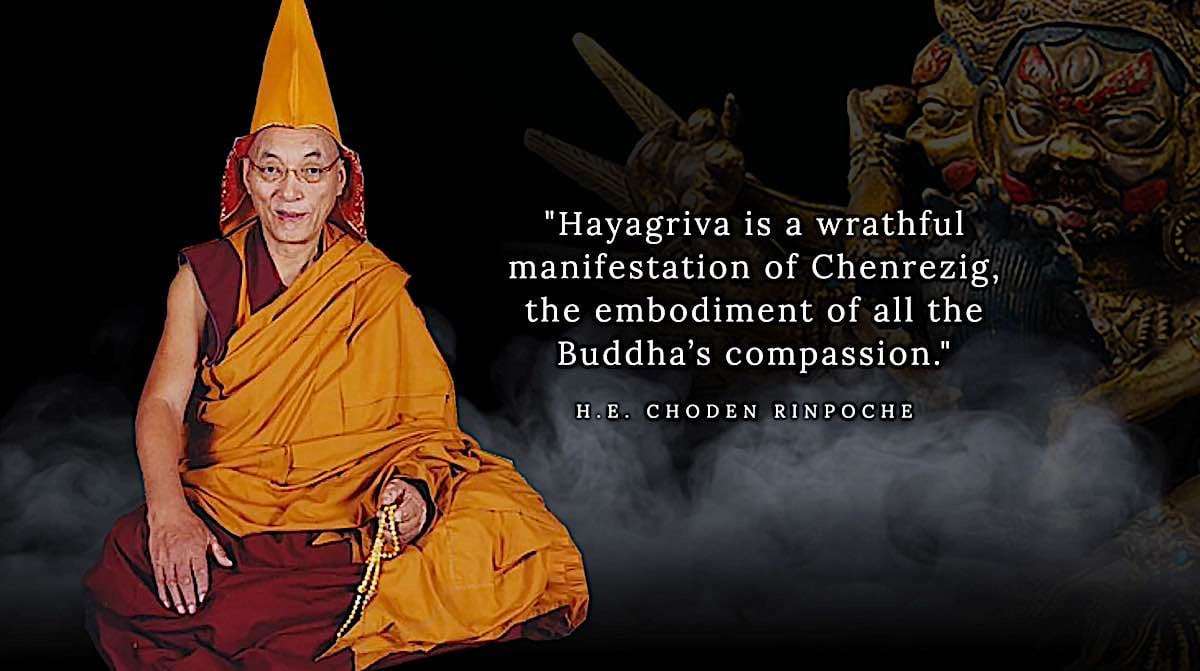
Transcript of Video
What makes Hayagriva practice unique and special in Buddhism? Choden Rinpoche explains:
“Hayagriva is a wrathful manifestation of Chenrezig, the embodiment of all the Buddha’s compassion.”
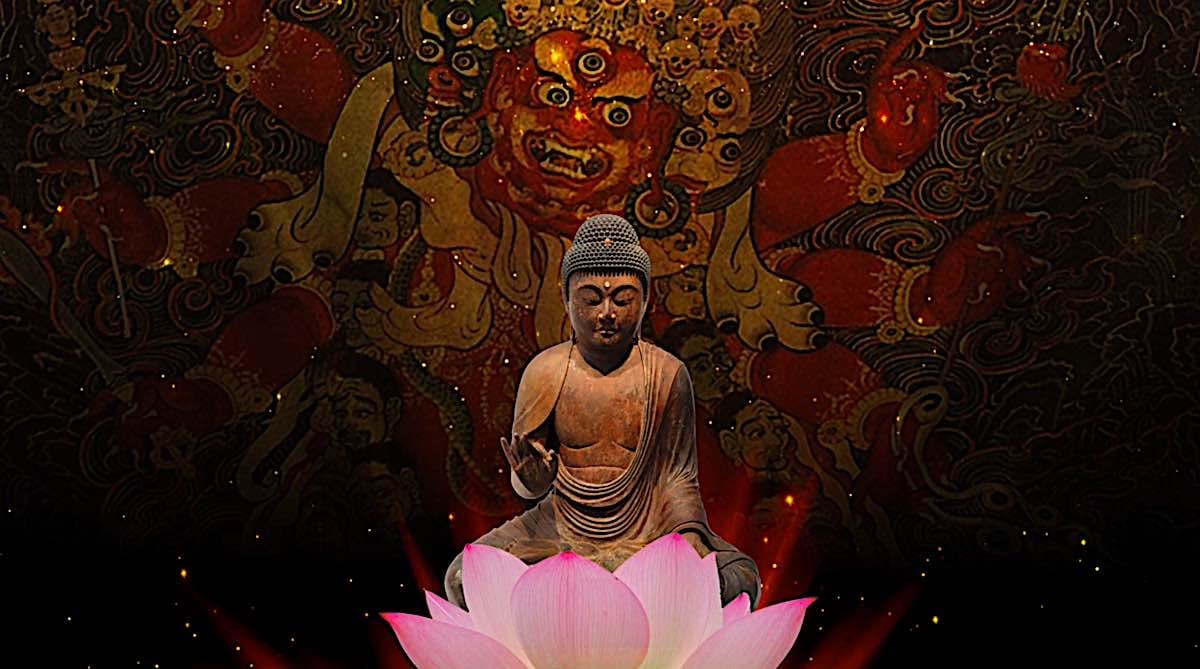
In the Sutra of Forming Hayagriva it is written:
“Whoever, including even the insects, has heard the name and mantra of Hayagriva only one time will never again fall into the lower paths.”
Many Buddhist teachers recommend Hayagriva as the practice most needed in modern times of rampant Egoism and Attachment.

Hayagriva the Incredible Hulk of Buddhas
Hayagriva — who is the Compassionate Buddha Amitabha’s most wrathful and powerful form — is the Heruka (the Hero) of the Lotus Padma Buddha Family. In modern terms, he is the “Incredible Hulk” manifestation of the Compassionate Buddha.
His irresistible “active” Discernment Wisdom is what many modern people need.
Great teachers in modern times continue to request their students accumulate Hayagriva Heruka’s mantra — known to be particularly efficacious in these troubled times.
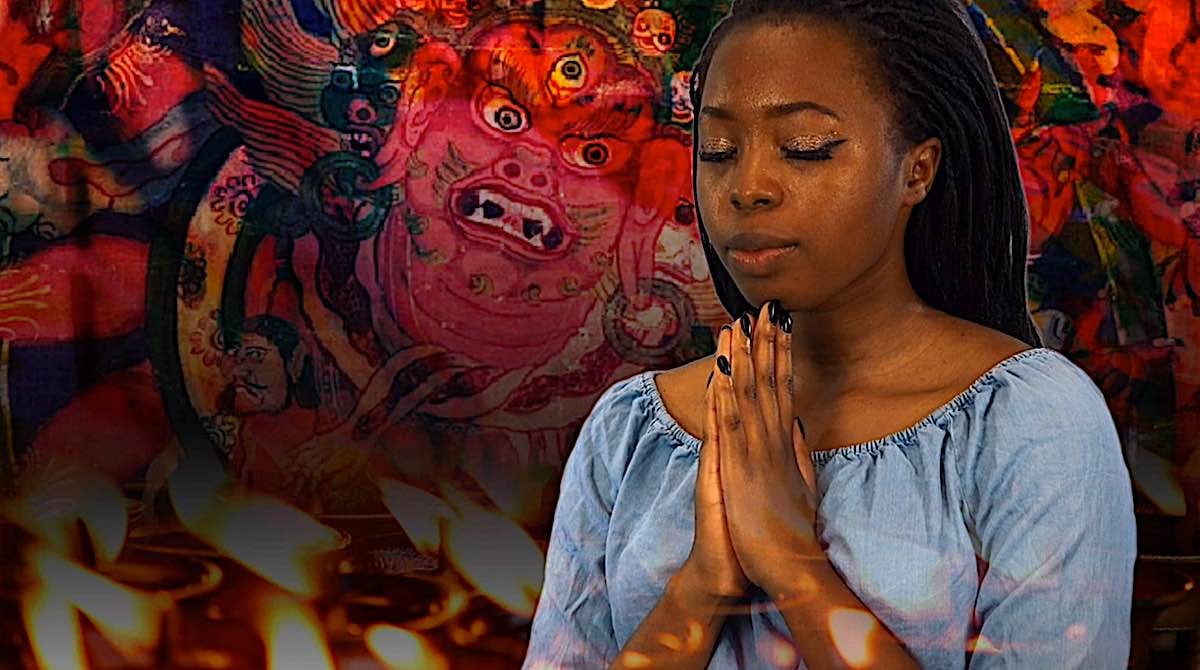
Hayagriva for Troubled Times
Lama Jigme Rinpoche explains:
“In today’s age, it is a degenerate time where the five poisons and negative emotions are very strong. So we need a deity like Hayagriva to empower ourselves. Also, negative influences today are so strong, such as the coronavirus.”
Choden Rinpoche described Hayagriva practice as “a swift and powerful means to overcome negative forces and obstacles. Prayers to Hayagriva are especially beneficial in these degenerate times when sufferings and illnesses are rampant due to the strong delusions of sentient beings.”
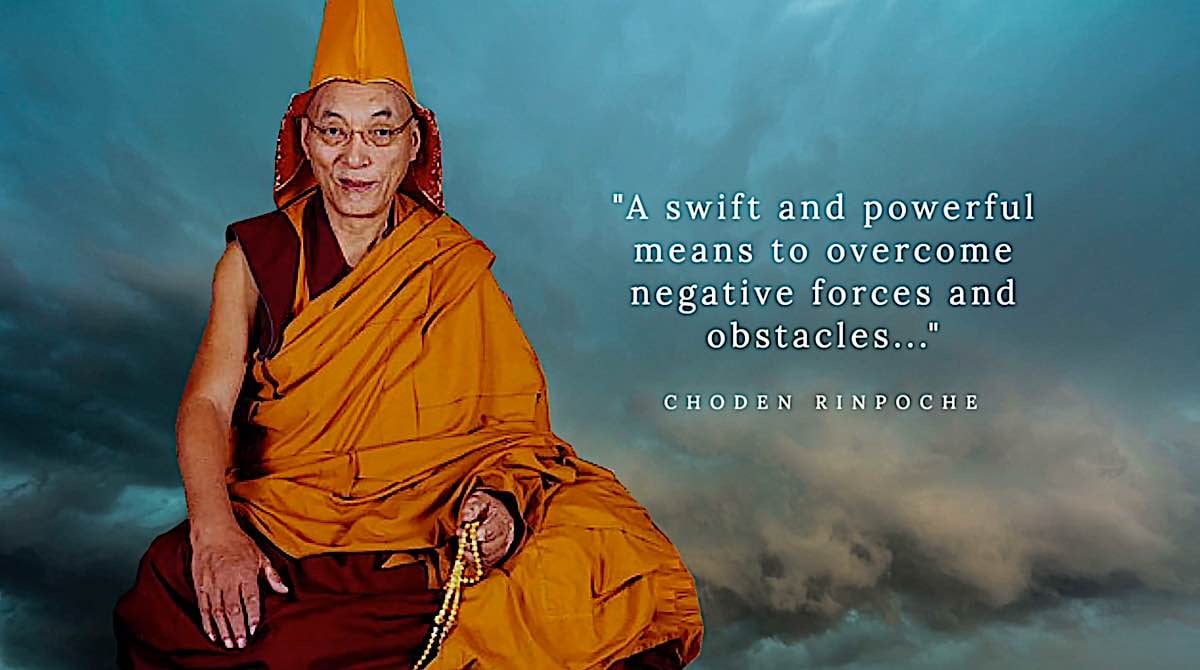
Hayagriva was one of the main Enlightened deities practiced by the great Lotus-Born Buddha Padmasambhava to banish hindrances and obstacles after he arrived in Tibet.
Lady Yeshe Tsogyal, in her biography, wrote: Guru Rinpoche ” arose in the form of Padma Heruka, ferocious and strong, the heruka of the secret sign.”

Hayagriva — Main Practice of Shabkar
Hayagriva was also the main practice of the great Shabkar and other accomplished yogis. In his autobiography, Shabkar described his initiation by Chogyal Rinpoche:
“At dawn the following morning, he bestowed on us the maturing empowerment of the Victorious One, the Wish-fulfilling Gem, Hayagriva and Varahi.”
This is a profound and extraordinary teaching from the cycle of the new treasures.
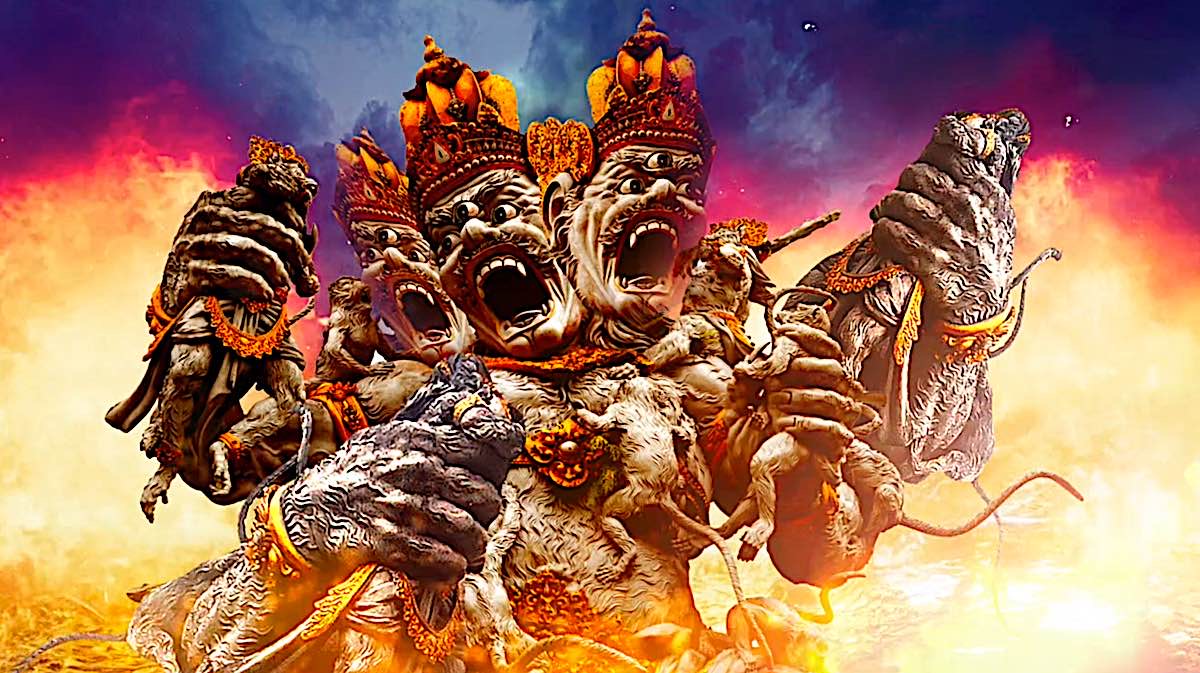
In heaven, the lineage of vidyadharas remains unbroken; on earth, the lines and colors of the mandala have not yet vanished; in between, the heaps of sacred substances have not yet diminished.
Unsullied by demons and samaya-breakers, it still carries the fresh breath of both the wisdom dakinis and worldly dakinis.”
Shabkar indicated in this quote that Hayagriva’s “mandala has not yet vanished.”
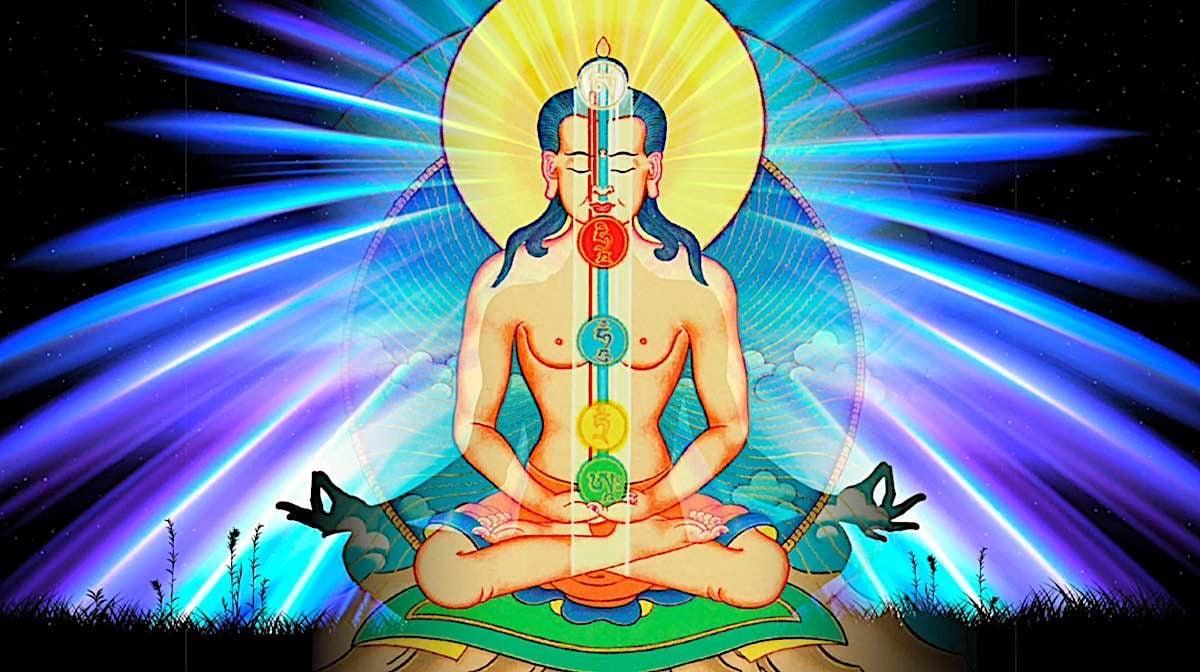
In other words, Hayagriva is very much accessible to practitioners today — not just the ancient masters.
The power of Hayagriva in our modern world is symbolically and tangibly demonstrated by the sixty-four sacred places in our world that still exist today — created when Hayagriva battled the Rudra Demon — (Ego) — to save the world.
The Origin of Hayagriva from Amitabha
As with all Tantric elements, the story of Hayagriva’s origin is meaningful and rich with symbolism. This story is told in the Sutra for Forming Hayagriva, quoted from the book — Esoteric Teachings of the Tibetan Tantra:
“In the time long past when the Great Bliss-Beyond-Effort, the Lotus Dancing-Master, the Lord Buddha Amida was staying in the Heaven of Aog-min, a vicious demon named Dregs Byod Tshogs Sprul (prideful actor multitude-conjurer) roamed the worlds, committing various evils and doing grievous harm to all sentient beings.
“Therefore the Lord Amida conjured the Mandala of the Green Hayagriva, and by this subjugated the demon. Whereupon the great Mandala of Hayagriva was elaborated, the Tantra of Hayagriva preached. This caused the king of all demons great distress.
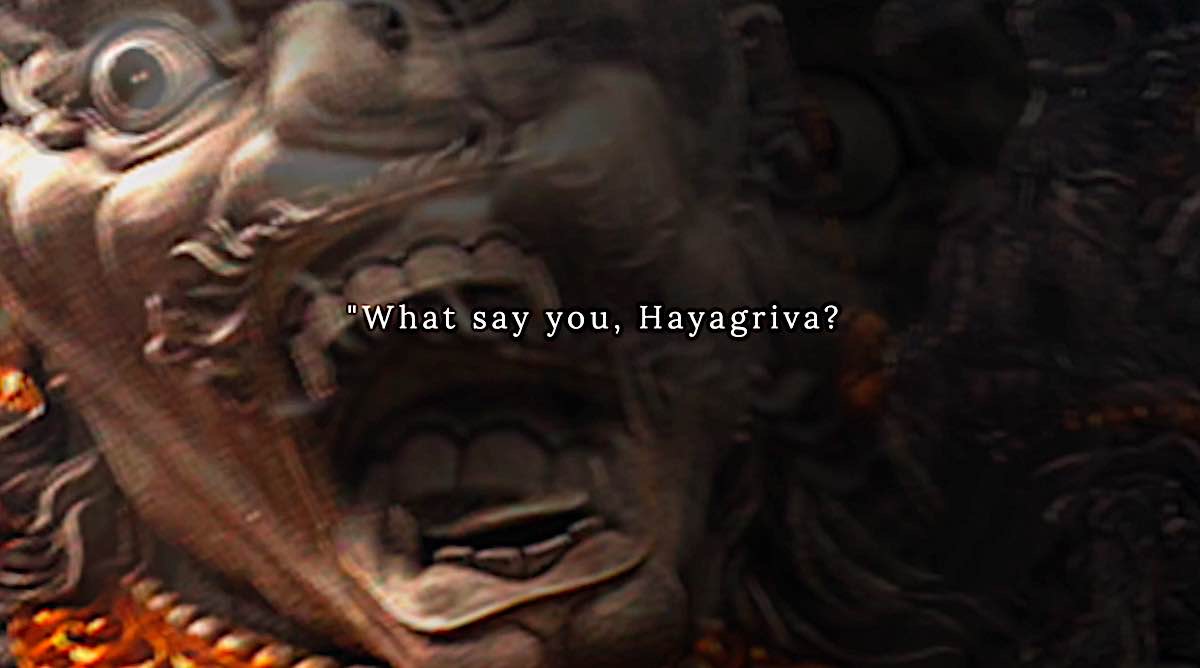
The most enduring and symbolic tale of Hayagriva, a demonstration of the power of the wrathful Wisdom of Discernment to overcome Ego, is described in more detail in chapters 5-8 of Padma Thangyig Serteng or The Golden Rosary of the Lotus-born, as documented by Khandro Yeshe Tsogyal.
More Detailed Story from Tantra
In this more detailed story, it is Hayagriva, as compassionate activity, and his consort Vajra Varahi, as wisdom, who together defeat black Rudra.
Hayagriva’s skillful, wrathful means, designed to overcome rampant ego and attachments, is described as a world-changing event, a battle beyond epic.
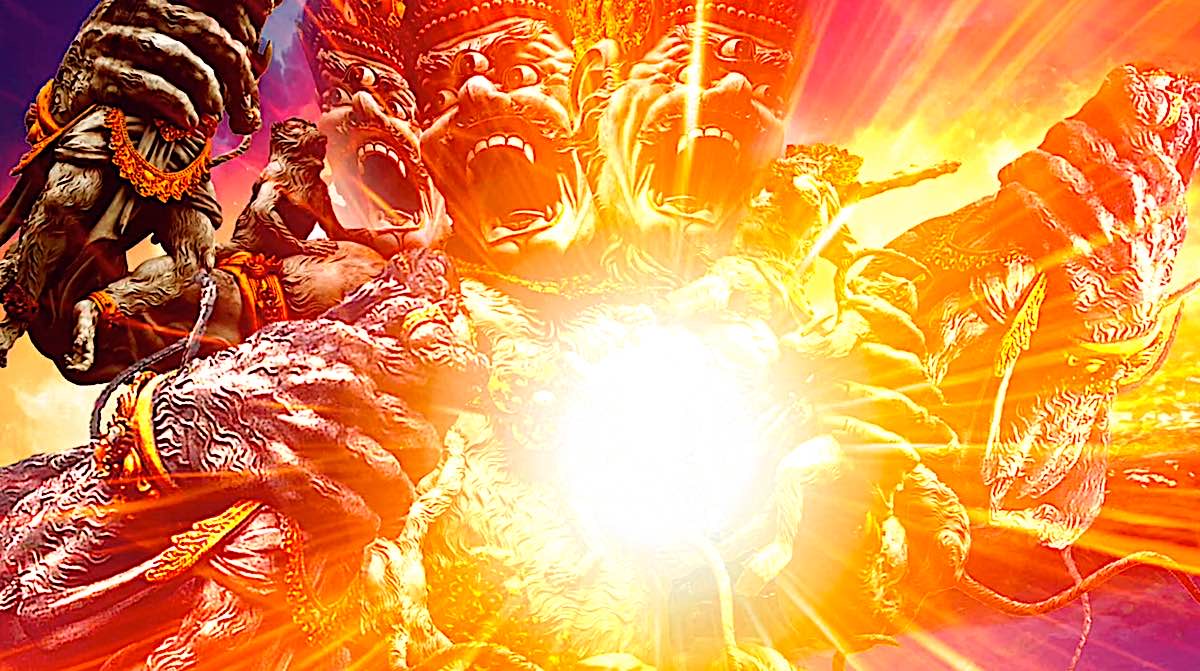
In the legend, the world was devastated by the Rudra “Black Salvation.”
All peaceful means to suppress Rudra failed. These were desperate times:
Nagpo was indeed black, and horrible to look at with his three heads, each with three eyes.
He had six hands, four feet and two wings.
Immediately at his birth all the auspicious signs of the country disappeared, and the eighteen inauspicious ones appeared.
Malignant epidemics attacked the whole region of Lanka-puri.
Some died, others only suffered, but all were in misery.
Lamentation, famine and sorrow beset the land.
There were disease, bloodshed, mildew, hailstorms, droughts, floods and all other kinds of calamities.
Even dreams were frightful, and ominous signs portending a great catastrophe oppressed everyone.
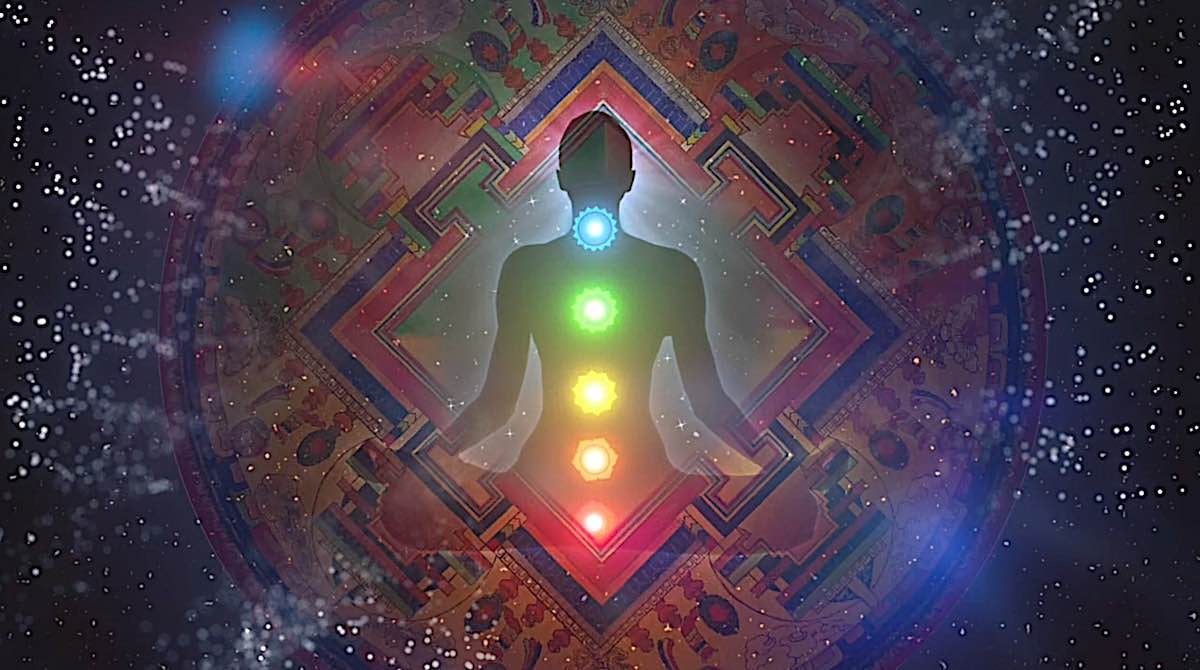
Evil Spirits Roamed the Land
Evil spirits roamed the land.
So great were the evils that it seemed as if the merit of everyone had been exhausted all at once…” So terrible was this demon, that he proclaimed:
Who is there greater and mightier than I?
If there be any Lord who would excel me, Him too will I subjugate.”
The hope against this apocalyptic demon was none other than Hayagriva and Vajravarahi.
“This demon will have to be ground down — wiped out to the last atom, in this one body.
Divine Horse-headed [Hayagriva] is the one who will dispel this threatening misfortune…”
Later, after overcoming Rudra’s retinue, Hayagriva faced Rudra with the Neigh of the Horse — symbolic of the Dharma voice and wrathful discerning wisdom. His consort Vajravarahi challenged with the Grunt of the Sow — symbolic of the Blissful Wisdom of Emptiness. “Then the Glorious One as Hayagriva, with his divine consort, Vajravarahi, each expressed their triumph by neighing and grunting three times. Hearing that — Rudra was struck with mortal fear — but coming to the spot he said:
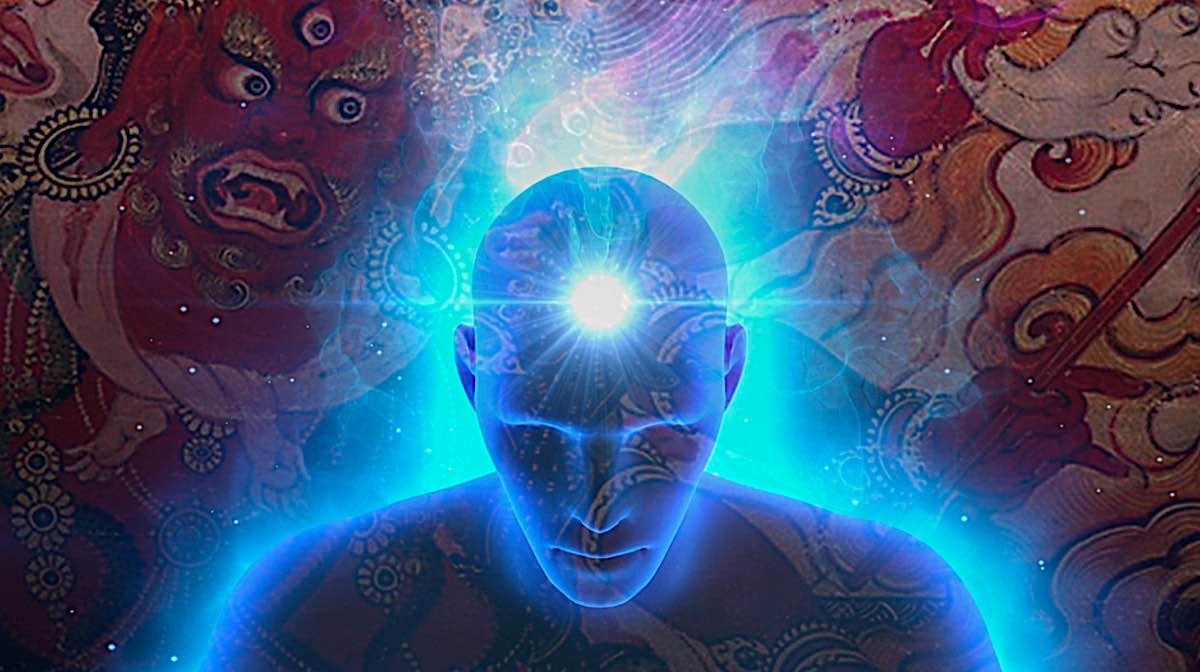
The Triumph of Hayagriva and Vajravarahi
“Then the Glorious One as Hayagriva, with his divine consort, Vajravarahi, each expressed their triumph by neighing and grunting three times.
Hearing that Rudra was struck with mortal fear, but coming to the spot he said:
“What do you say, Hayagriva?
All inhabitants of the realm of devas and ashuras
Proclaim my virtues and sing my praises —
I cannot be conquered. Rest yourselves in peace,
Regard me with humility, and bow down to me.
Even the regent of the devas in his odd garb ,
In ages past, failed to conquer me.”
Saying this, he raised his hands to strike. Hayagriva fought back, and used wrathful force to obliterate the demon’s body. He impaled him right the way through, and burst through his head, his own horse-head on top of the head of the Demon. The oily fat of its body made the horse head look green. The horse’s main dyed with blood became red and the eye-brows splashed with its bile became yellow. The forehead splattered with brains became white. And so the Glorious One, having assumed the shape and costume of the Rudra, took on a terrible majesty.
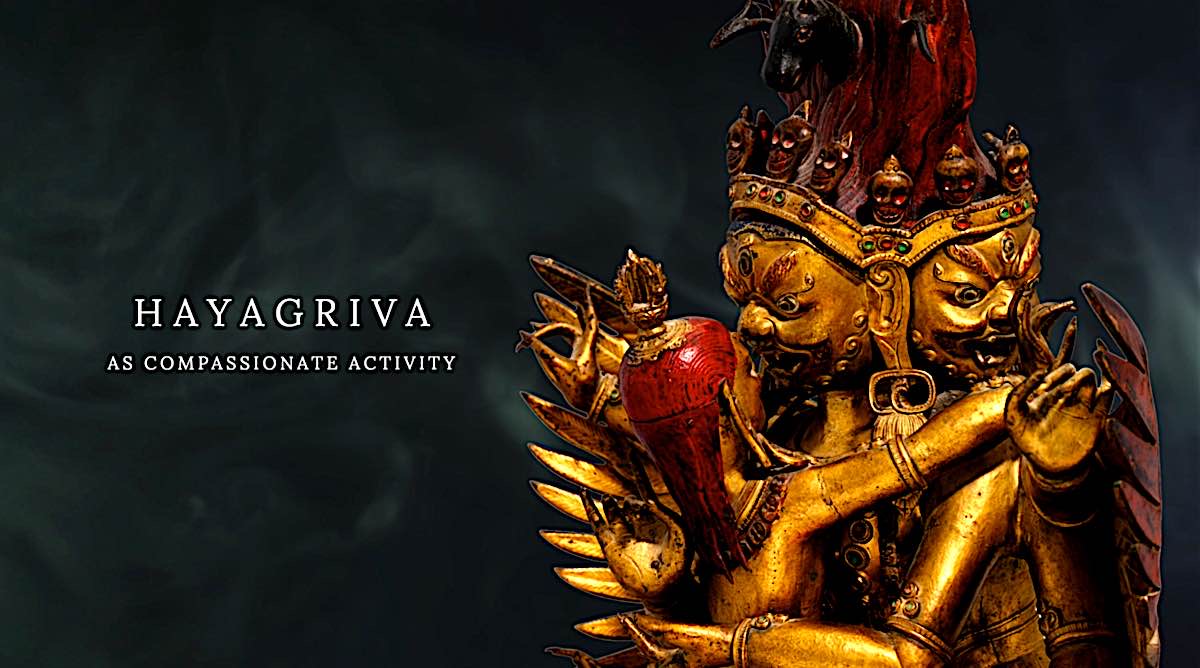
Profound Symbolism of the Legend
“There is something very profound to be understood here,” explained Orgyen Tobgyal in a teaching on the Wang Du.
Although Glorious Hayagriva and Varahi conquered Rudra — representing our Ego attached to our gross physical body — the Glorious Ones remained in our world, even today, helping those with faith.
Orgyen Tobgyal taught that Hayagriva and Var-ahi “scattered the remains of Rudra’s body throughout the world’s sixty-four power places –— twenty-four sacred places, thirty-two sacred lands, and eight great charnel grounds –— all of which are sacred to Hayagriva and Varahi.
Each place is guarded by a chief Daka and Dakini, who were emanated by Hayagriva and Varahi.
As their mandalas have yet to be dissolved, each place continues to be guarded and preserved as sacred fields of the profound Dharma.
The qualities of these profound Dharma fields are such that, through the power and blessings of the Dakas and Dakinis, by visiting just one of them, males will be blessed and become members of the Daka family, and females will be blessed and become members of the Dakini family.
These sacred places are associated with internal sacred places in all of our bodies — the channels and chakras in the internal body. The “battles” with worldly demons can be seen as metaphors for overcoming our own demons and attachments.
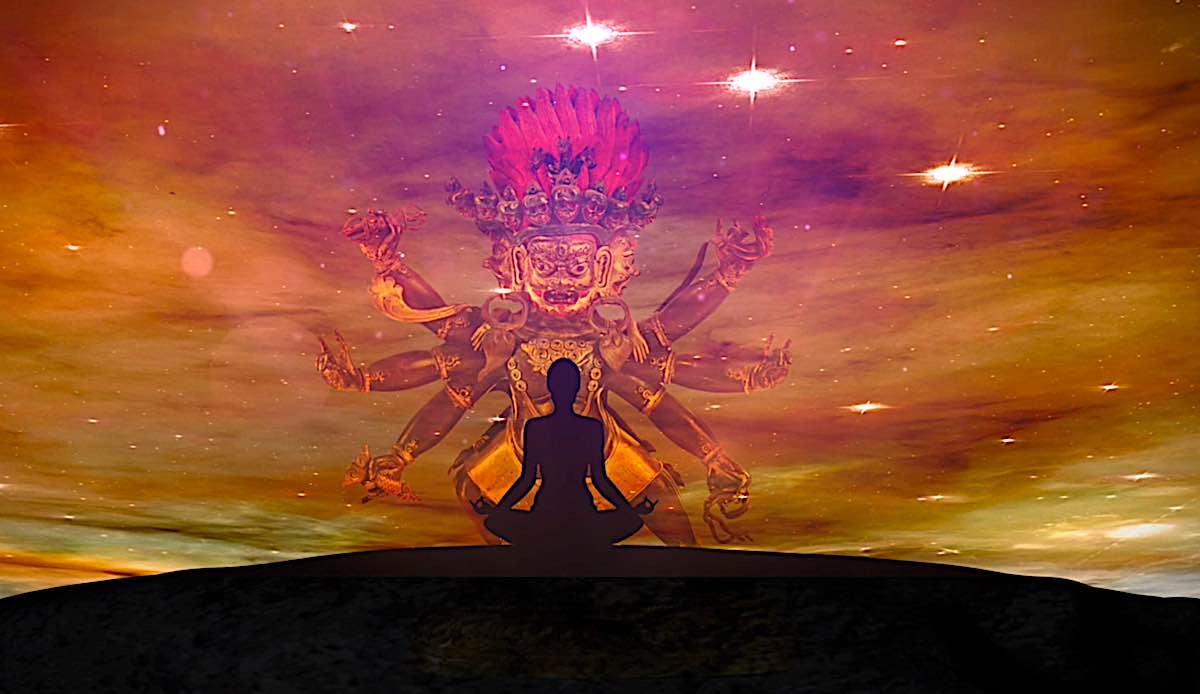
Symbolism of Hayagriva
When we listen to these ancient tales, they are rich with symbolism. What does it all mean? Why does a horse head erupt from the wrathful head? Why is a green? Horses are profoundly important symbols in Buddhism. The scream of the horse is piercing, ferocious, terrifying. A stallion’s roar can terrify a pack of wolves. Horses are also symbolic of WIND — in this context Lung (Tibetan), Prana (Sanskrit) and Chi (Chinese).
Why do we visualize such elaborate symbolism? Symbolism is the language of the mind. An image conveys more than words could. Venerable Lama Jigme also explains the purpose of practicing the development stage — or visualizing the self as the deity:
“The purpose of practicing the development stage is to refute the appearance and conception of ordinariness and to also teach clear manifestation to disprove appearance and have pride when you dispute conception.
Clear Manifestation is the aspect of the deity to be attained by holding to the mind.
Unfettered by appearance, fettered by conception.
“Cut down the conception!” The Great Master Naropa so said.”
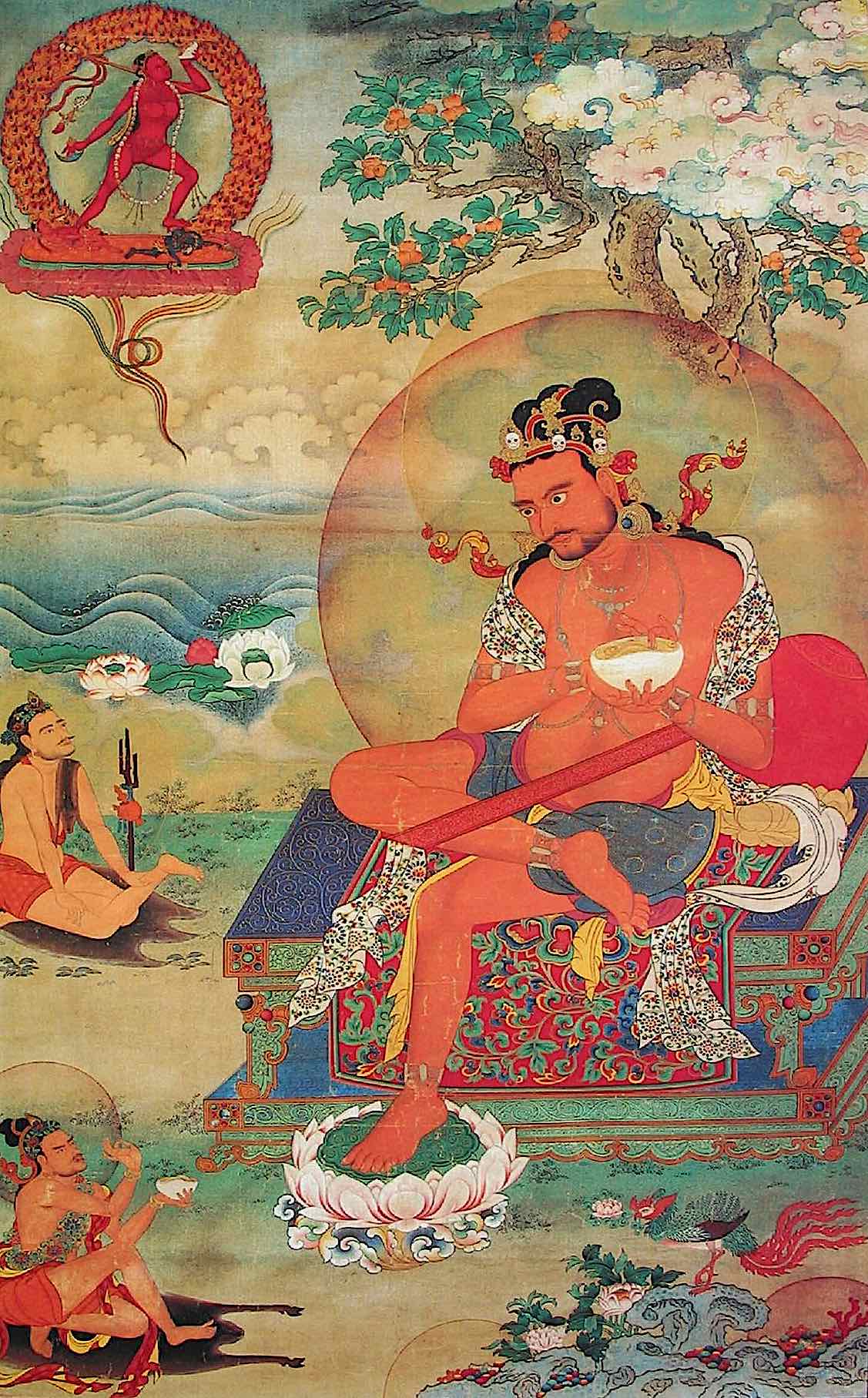
Hayagriva — the Speech of all the Buddhas
Overcoming incorrect conceptions may be important, but the overwhelming characteristic of Hayagriva, or any aspect of the Lotus or Padma family, is Speech and Dharma.
Of the three Jewels, it is often said by teachers that the most important is the Speech Jewel, the Dharma. The Buddha Jewel is our example, and the Sangha Jewel is our support, but it is the Dharma that points us to the path of Liberation and Enlightenment. Even if Buddha is gone beyond, and Sangha is not available to help us, the Dharma can always guide us.
As the Heruka of Amita’s Lotus Family, Hayagriva is Chief among the Wrathful emanations, representing Dharma and Speech in its ferocious form — signified by the horse head bursting out of his fiery red hair. Orgyen Tobgyal Rinpoche describes Hayagriva in this way:
“The Powerful Heruka is Hayagriva.
Every being that lives in this world has no choice but to follow Hayagriva’s command.
He is more powerful than any other being; there is no one to equal or even compete with him.
Hayagriva is the universal ruler of all that appears and exists.
His wisdom intent is enriched by the ‘three neighs’ – which is too vast a subject to explain right now.
What you need to understand about Hayagriva … is that there is no one greater or more powerful than the Powerful Heruka.”
Venerable Steve Carlier explains: “Hayagriva is a wrathful aspect of Chenresig.
Making prayers to Hayagriva is a swift and powerful means to overcome negative forces and obstacles including those caused by spirit harms.
Prayers to the deity are especially beneficial in these degenerate times when sufferings and illnesses are rampant due to the strong delusions of sentient beings.
As a manifestation of Chenresig, the practice of Hayagriva also helps to develop compassion.”
A Daily Tea Offering to Hayagriva
For those who wish to praise Hayagriva — but who may not yet have empowerment and instruction from a teacher — one way to develop merits and auspiciousness is to offer tea to Hayagriva each morning or evening, with the tea offering praise:
Hrih! Hayagriva, the nine gaited king, fierce and majestic,
You have come forth from the heart of Amita to defeat the evil designs of humans and non-human spirits.
I sing praises of you and your host of deities.
Who vanquish all foes of the Dharma and protect the practitioners;
I sing praises to you all.
Enter text here to generate voice over
O fierce Vajrah, born from the syllable hree
You, Hayagriva, cast your fierce gaze upon the troublemakers.
I prostrate to you who controls the three realms
Through the resounding voice of hulu hulu hum pey
I pray that you partake of the ritual cakes and sacred offerings
Multiply your fourfold actions of peace, increase, power and wrath
Increasing the life, good health, merit, glory, and wealth,
Of myself and my retinue, and those your yogis, teachers, and disciples.
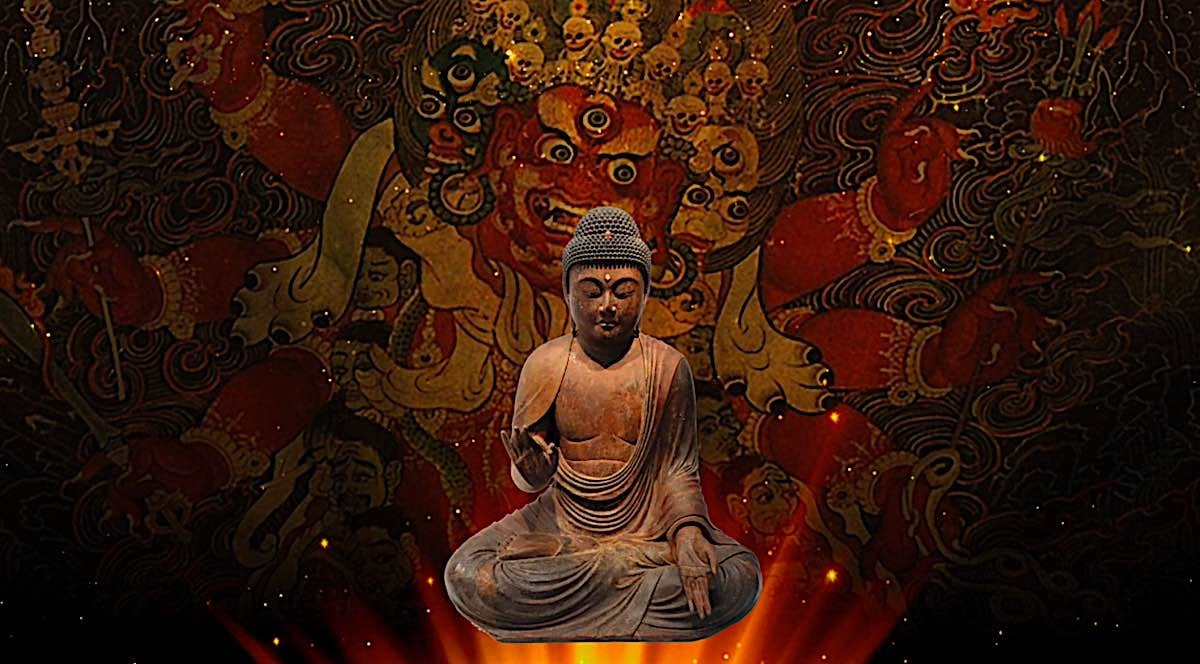
The King of All Protections
The benefits to the initiated devotee who practices the Yoga of Hayagriva were stated in The Manifestation of the Superb Victorious Wrathful Great Horse Tantra :
“To the superb Initiation of the Fierce Hayagriva
And the victorious Tantra of great value!
If one surely beholds the initiation and has a fancy for it, he will be emancipated from fear and all diseases.
Those who practice the Yoga of Hayagriva, their patron Buddha,
Will be immune for seven hundred births from falling into the lower path and hell.
Those who have the faith and the pure realization constantly,
Will in their future life be born in the Pure Land.
If one recites each word of mantra 100,000 times,
Right in this life he shall see the face of Hayagriva.
Even in offering a part of the offerings to the Lord,
He will influence his surroundings and his neighbors.
Those who merely recite the mantra frequently
Will be free from the afflictions caused by evil spirits.”
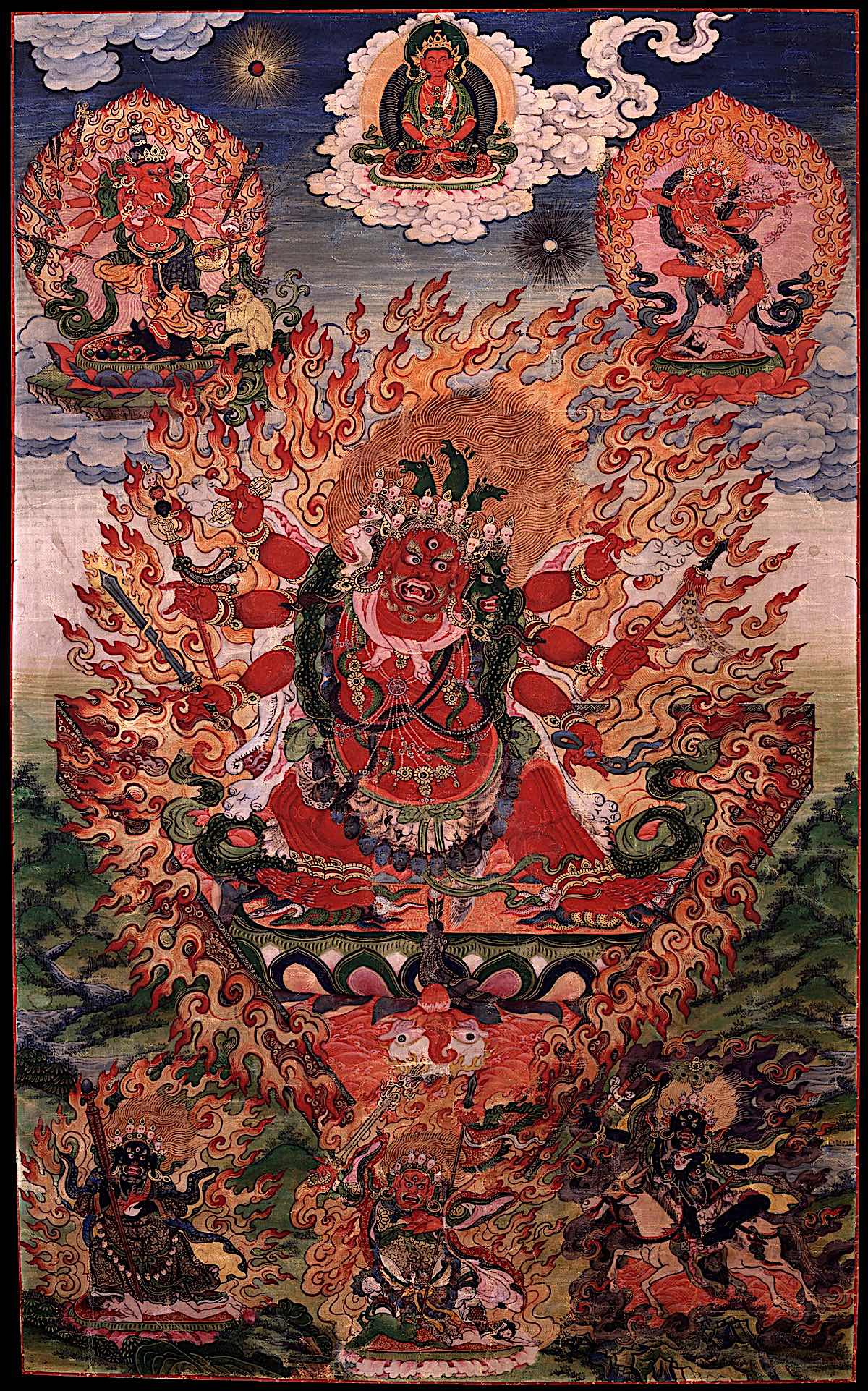
At the bottom center is Begtse Chen (Red Mahakala: see below), red in colour. On the left is Legden Mahakala (left, see below), blue in colour and right is Shri Devi Magzor Gyalmo (Palden Lhamo, the protector of the Dalai Lama).
Hayagriva is the “king of all Protections.”
Don’t miss the other in-depth Buddha Dharma videos from Buddha Weekly, covering all aspects of Buddhist practice. If you liked this presentation, please subscribe to our YouTube Channel https://www.youtube.com/buddhaweekly and turn on notifications. Thank you for watching.
1 thought on “Hayagriva Buddha Documentary: Why is Hayagriva recommended by Buddhist Teachers in difficult times?”
Leave a Comment
More articles by this author

VIDEO: Vajrapani Vajra Armor Mantra: Supreme Protection of Dorje Godrab Vajrakavaca from Padmasambhava
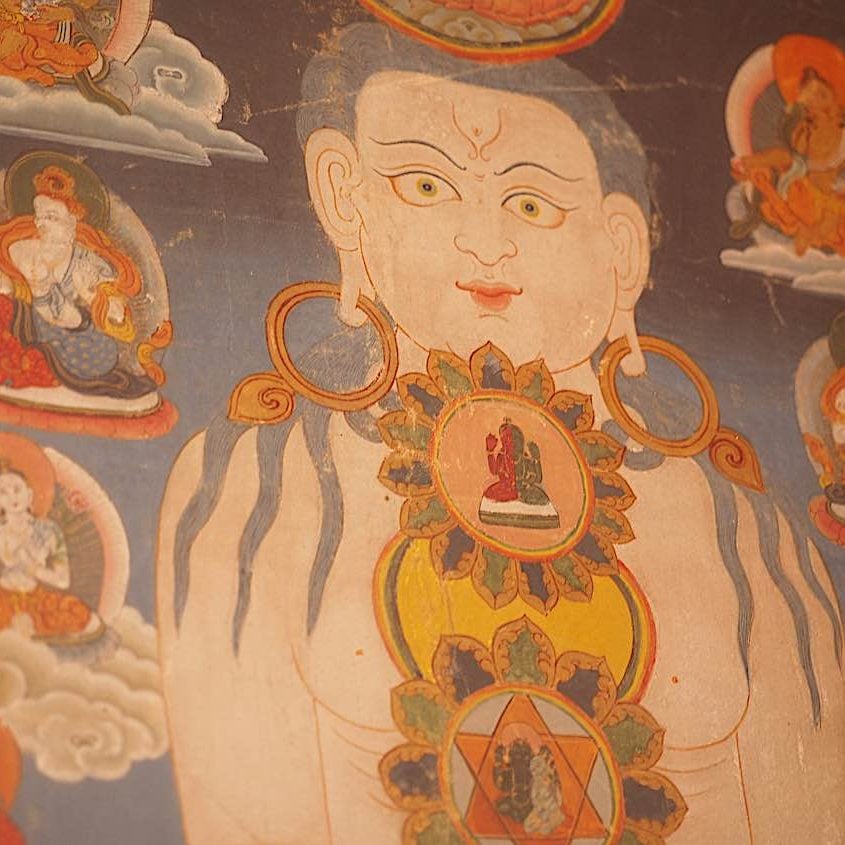
Buddhist body mandala practice in Vajrayana Buddhism — and riding the winds of the inner body “The prana goes where the mind goes.””
Search
Latest Features
Please support the "Spread the Dharma" mission as one of our heroic Dharma Supporting Members, or with a one-time donation.
Please Help Support the “Spread the Dharma” Mission!

Be a part of the noble mission as a supporting member or a patron, or a volunteer contributor of content.
The power of Dharma to help sentient beings, in part, lies in ensuring access to Buddha’s precious Dharma — the mission of Buddha Weekly. We can’t do it without you!
A non-profit association since 2007, Buddha Weekly published many feature articles, videos, and, podcasts. Please consider supporting the mission to preserve and “Spread the Dharma." Your support as either a patron or a supporting member helps defray the high costs of producing quality Dharma content. Thank you! Learn more here, or become one of our super karma heroes on Patreon.
Lee Kane
Author | Buddha Weekly
Lee Kane is the editor of Buddha Weekly, since 2007. His main focuses as a writer are mindfulness techniques, meditation, Dharma and Sutra commentaries, Buddhist practices, international perspectives and traditions, Vajrayana, Mahayana, Zen. He also covers various events.
Lee also contributes as a writer to various other online magazines and blogs.





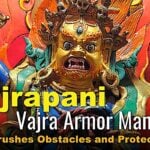
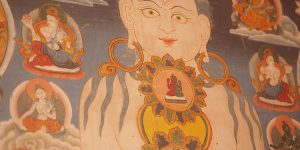

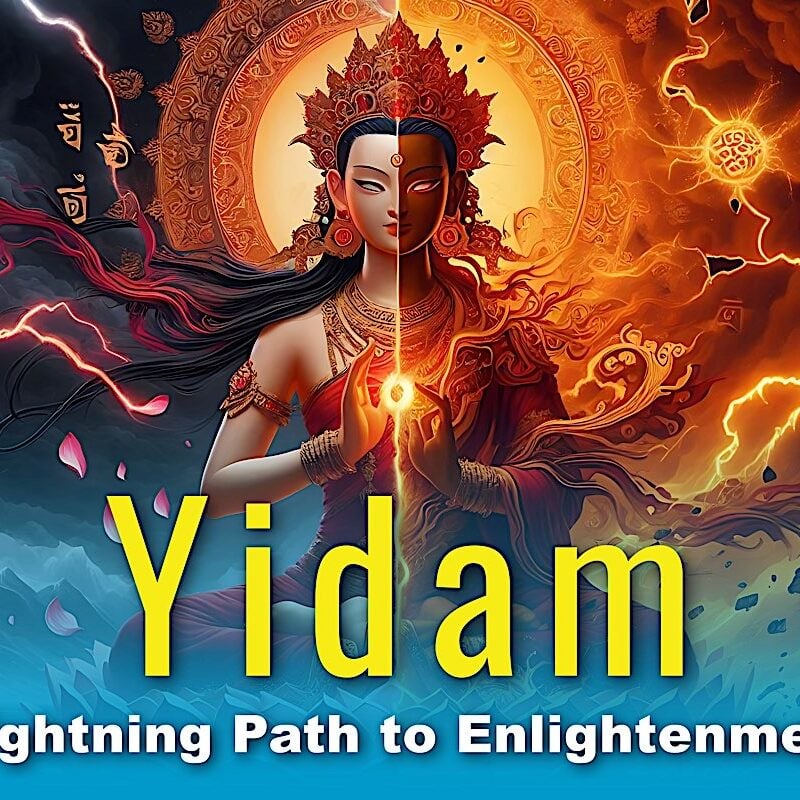
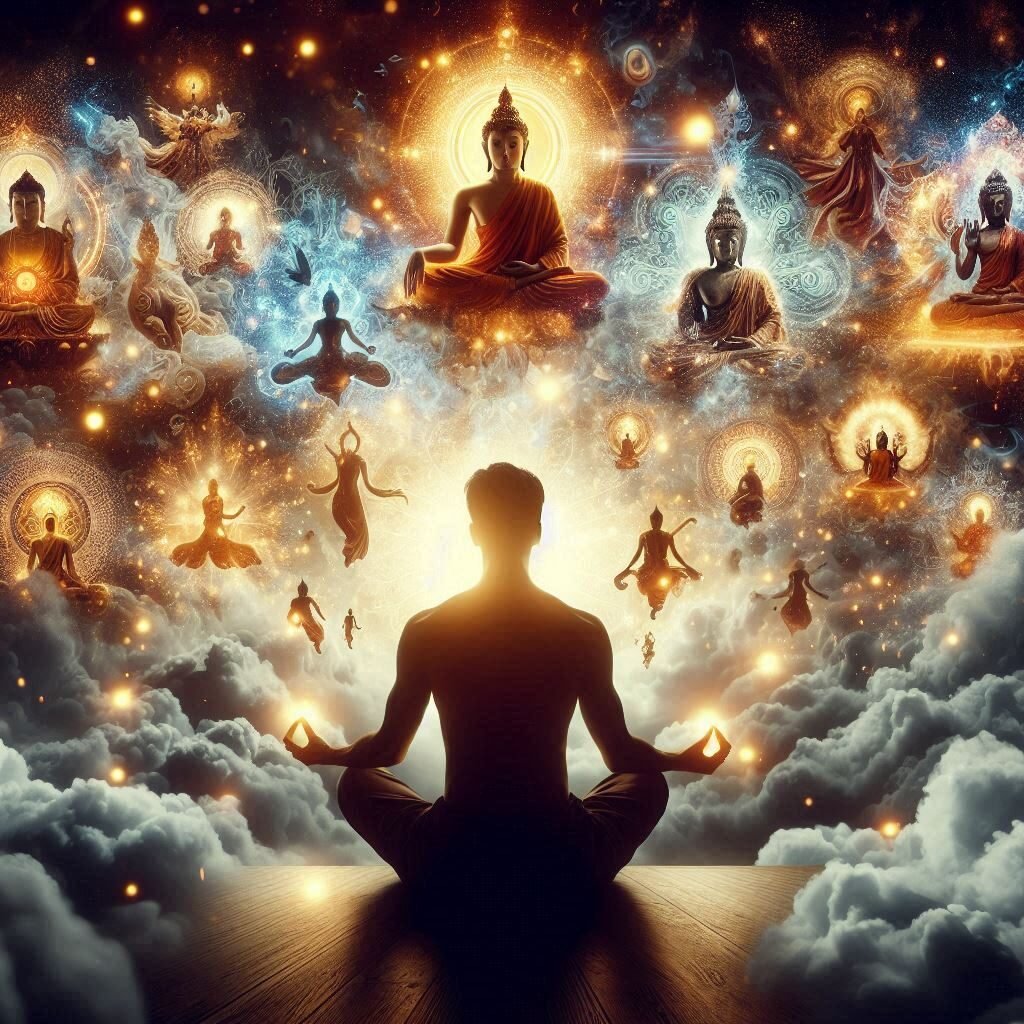
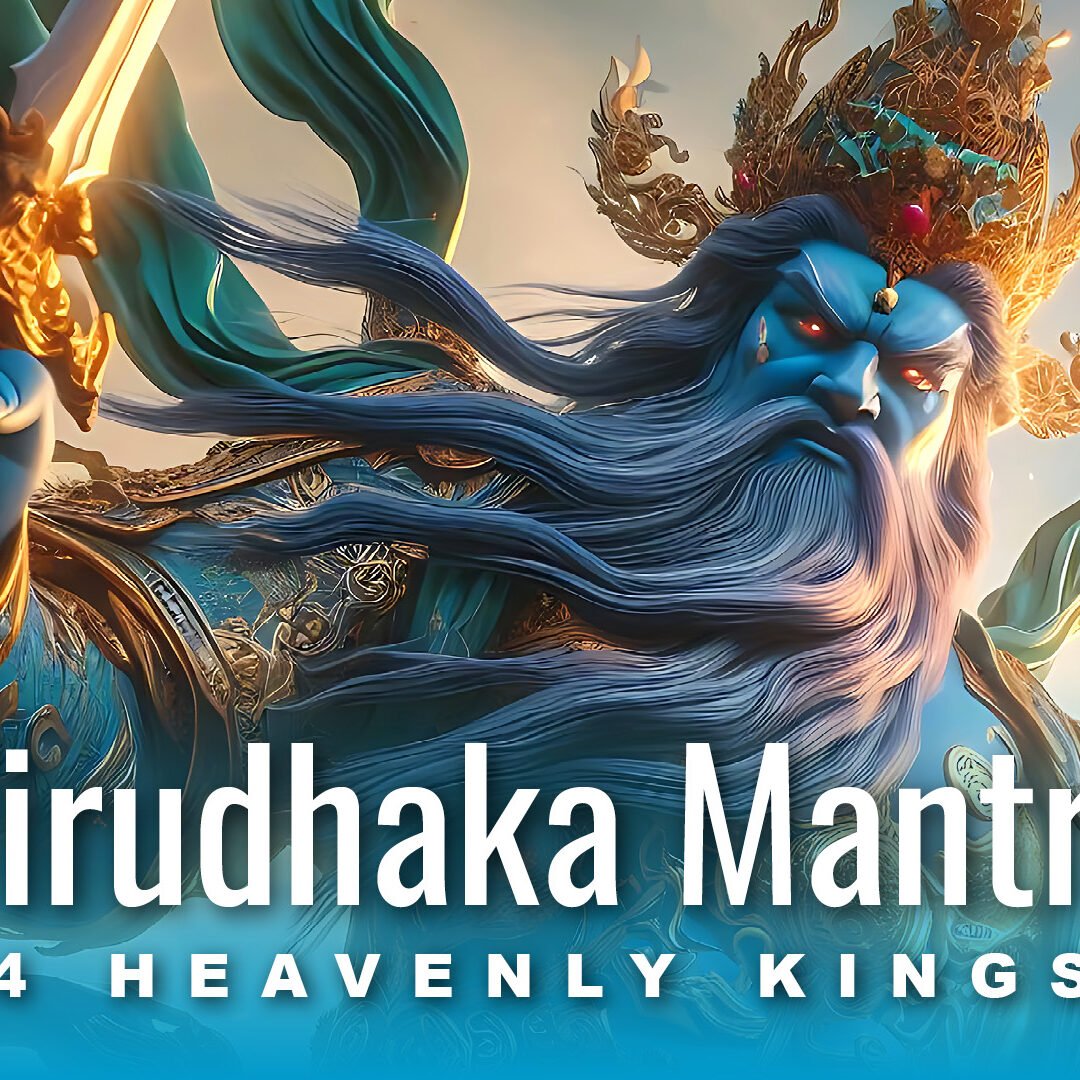
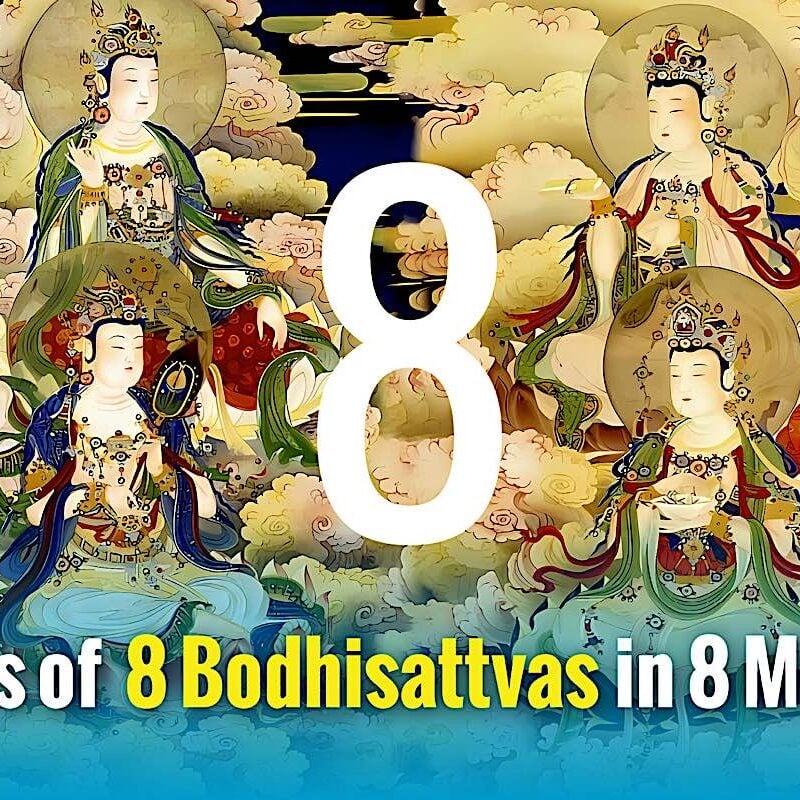

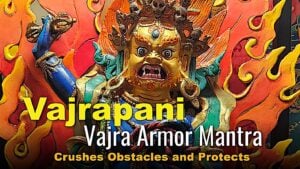
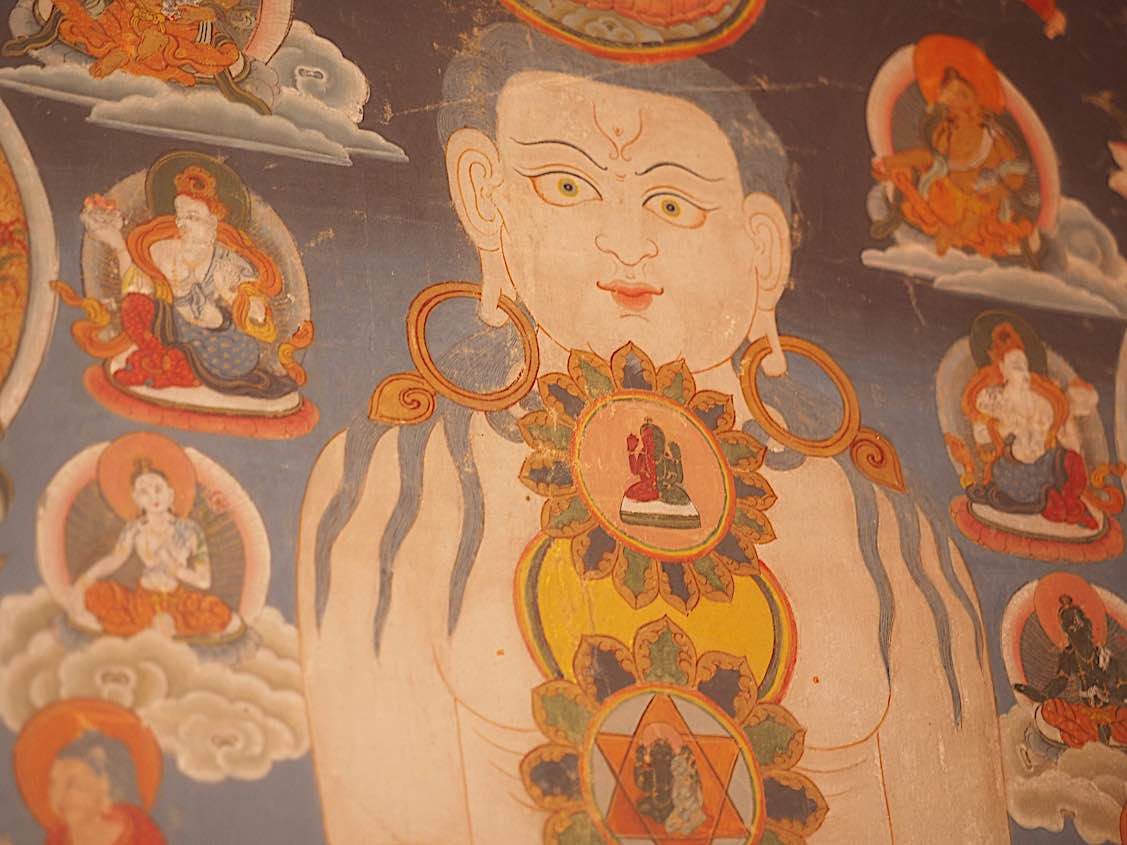


Thank you for this detailed and very helpful work. I could not see it detialed, is it known where the 64 holy places are currently on the earth?